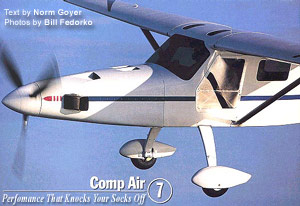COMP AIR 7 - "Performance That Knocks Your Socks Off"
Text by Norm Goyer -- Photos by Bill Fedorko
 WHEN I FIRST saw the Comp Air 7, I
exclaimed, 'What a schnozz!" The Comp Air 7 has such a big nose, it's got
to be the Pinocchio of homebuilts. But no lie -- it delivers truly
impressive performance. The Comp Air 7 got that way when Aerocomp replaced
the big Continental with a 600-hp Walter 601 D turbine engine. It didn't
gain any weight, but to cover that large engine, the cowling had to be
lengthened considerably. Even those who don't think it's all that
attractive will quickly forget about its looks once they pour on the coals
(in this case, kerosene). It goes so fast that it can take off before you
get to the end of a hangar, and it goes faster almost straight up!
WHEN I FIRST saw the Comp Air 7, I
exclaimed, 'What a schnozz!" The Comp Air 7 has such a big nose, it's got
to be the Pinocchio of homebuilts. But no lie -- it delivers truly
impressive performance. The Comp Air 7 got that way when Aerocomp replaced
the big Continental with a 600-hp Walter 601 D turbine engine. It didn't
gain any weight, but to cover that large engine, the cowling had to be
lengthened considerably. Even those who don't think it's all that
attractive will quickly forget about its looks once they pour on the coals
(in this case, kerosene). It goes so fast that it can take off before you
get to the end of a hangar, and it goes faster almost straight up!
The Comp Air 7 is constructed entirely of
composite materials and uses much of the same aerodynamic design used by
the outstanding Merlin aircraft. It retained the high-lift airfoil (which
looks to me like a good old Clark Y). Its fuselage is large and wide, and
could easily seat three across, if it weren't for the control sticks and
power quadrant in the middle. Yes, the Comp Air 7 comes with control
sticks rather than a control wheel, and the instruments are calibrated in
mph rather than in knots. The Comp Air 7 has graduated from being an airplane
with home-built characteristics and has found its place in the world of fast,
executive-type aircraft.
It's quite capable of flying IFR and is so stable that it would be an
ideal instrument platform. I've logged thousands of hours flying airplanes
with control sticks, and while I do enjoy them, the majority of today's
personal executive transport aircraft are equipped with control wheels and
instruments calibrated in knots not mph. I don't know why the company took
the other route. I attempted to foist my ideas on anybody at the company
who'd listen, but I got shot down. Everyone loved the sticks, and having
the instruments marked in mph didn't bother them.
The interior of the aircraft was rather
spartan, except for the seats and carpets that were very comfortable and
plush. They reminded me of the accommodations in some modern SUVS. The
instrument panel had all the normal flight instruments, plus some new
ones, to monitor the progress and temperatures of the Walter engine. The
throttle quadrant had a prop control including beta, a start
andcut-off fuel knob and, of course, the
turbine fuel-feed throttle. Any pilot will find it easy to switch from
operating a reciprocating engine to running a turbine. If you're wondering
how to fire-up these blow-torches, follow me as we prepare to take the
Comp Air 7 with a Walter engine package for a test flight.
There are some very different rules to be strictly followed when
starting a turbine engine vs. a reciprocating one. First, be sure to turn
the plane into the wind (if there's any of a significant velocity) to
prevent the wind from blowing into the plane's huge exhaust stack. Next,
to prevent any possible damage from the prop-blast and turbine heat, make
a careful visual check to be sure there's nostructure or another aircraft behind your
plane. Start by checking the position of the fuel-tank valve. Move the
indicator to "both" or to the correct tank.
|